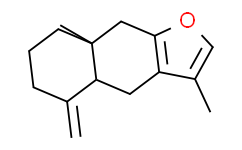| Cas No.: | 6989-21-5 |
| Chemical Name: | Atractylon |
| Synonyms: | (4aS,8aR)-3,8a-Dimethyl-5-methylene-4,4a,5,6,7,8,8a,9-octahydronaphtho[2,3-b]furan;ATRACTYLINE(DISCONTINUED)(SH);(4aS)-4,4aα,5,6,7,8,8a,9-Octahydro-3,8aβ-dimethyl-5-methylenenaphtho[2,3-b]furan;Naphtho[2,3-b]furan, 4,4a,5,6,7,8,8a,9-octahydro-3,8a-diMethyl-5-Methylene-, (4aS,8aR)-;(4aS,8aR)-4,4a,5,6,7,8,8a,9-Octahydro-3,8a-dimethyl-5-methylene-naphtho[2,3-b]furan;Atractylon;(4aS,8aR)-3,8a-dimethyl-5-methylidene-4,4a,6,7,8,9-hexahydrobenzo[f][1]benzofuran;Atractylone;Atractyloxide;Atractylol;Naphtho(2,3-b)furan, 4,4a,5,6,7,8,8a,9-octahydro-3,8a-dimethyl-5-methylene-, (4aS-trans)-;BCP16937;BDBM50241938;AK128304;AX8250095;ST24034758;C16919;(4aS,8aR)-3,8a-dimethyl-5-methylidene-4,4a,6,7,8,9-hexahydrobenzo |
| SMILES: | O1C([H])=C(C([H])([H])[H])C2=C1C([H])([H])[C@@]1(C([H])([H])[H])C([H])([H])C([H])([H])C([H])([H])C(=C([H])[H])[C@]1([H])C2([H])[H] |
| Formula: | C15H20O |
| M.Wt: | 216.3187 |
| Purity: | >98% |
| Sotrage: | 2 years -20°C Powder, 2 weeks 4°C in DMSO, 6 months -80°C in DMSO |
| Description: | Atractylone (Atractylon) is a sesquiterpenoid extracted from Atractylodis Rhizoma. Atractylone (Atractylon) alleviates influenza A virus (IAV)-induced lung injury via regulating the TLR7 signaling pathway, and acts as a promising agent for IAV treatment. Atractylone (Atractylon) inhibits the degranulation of mast cell and exhibits potential for the treatment of mast cell-mediated allergic reactions[1][2]. |
| References: | [1]. Cheng Y, et al. Antiviral activities of atractylon from Atractylodis Rhizoma. Mol Med Rep. 2016 Oct;14(4):3704-10. [2]. Han NR, et al. Inhibitory effects of atractylone on mast cell-mediated allergic reactions. Chem Biol Interact. 2016 Oct 25;258:59-68. |






















